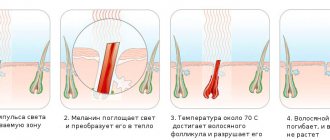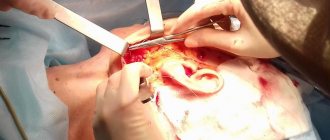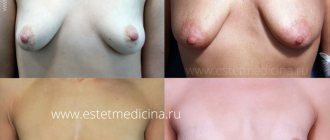For many active readers of the site, the concept of “circular or vertical mastopexy” has become familiar, and inverted T-shaped mastopexy or reduction (reduction) is usually called “anchor breast lift.” From a professional point of view, the concept of “vertical mammoplasty” is a specific concept, a fundamental approach to the technique of performing an operation under the general name “breast lifting or reduction of the mammary glands.”
When performing a breast lift, a plastic surgeon is required to not only “gather” sagging, splayed breasts, but also “put” the newly created wealth into a small vertical seam. In this case, it is necessary to carefully avoid performing a horizontal inframammary suture. In any case, make it as short as possible. It is a known fact that the inframammary suture most often looks unattractive due to its hypertrophy (coarse scarring).
Almost always, when performing mammoplasty, a circular incision is made around the areola, since it is necessary to move (often reduce in size) the areola higher to an aesthetically attractive position. In most cases of mastopexy, a vertical suture is also required. Attempts by some surgeons (sometimes to please patients) to use only a circular suture when there are indications for a full breast lift most often lead to rough scarring of the sutures around the areola (due to strong tension) and flattening (loss of cone shape) of the mammary glands. Foreign authors call the shape of such breasts “Tomato breast.” That is, the chest looks like a tomato. And there is logical, physically and geometrically proven confirmation of this. I can refer particularly inquisitive readers to A.M. Borovikov’s monograph “Ptosis of the mammary glands.”
So. What is important for a surgeon when performing a breast lift? :
- Assessment of the condition of the mammary glands (the very structure of the parenchyma and skin).
- Correct markings.
- Virtual vision of the “assembled” mammary gland when it is still in a “disassembled” state. Call it what you want - experience, intuition, mathematical or vice versa - artistic approach, etc.
- Having some experience in using a different, unplanned method of correction if “something doesn’t go as planned.” In other words, it is not enough for a surgeon to be able to “harvest” the gland in only one way or technique.
- The ability (all plastic surgeons should have this, of course) to “sew” correctly.
The rest, as they say, will follow.
What is important for a patient when performing a breast lift is the ability to find the right plastic surgeon (just kidding). Of course, trust the chosen doctor (logically, calculatedly, or intuitively - it doesn’t matter) and be positively disposed to an excellent result. Of course, that's not all. The rest – everyone has their own views on this point (surgeon’s experience, results, reviews, financial side, etc.).
We will try to explain the above in more detail as we comment on the stages of the operation. So to speak, “put it into pieces.”
Photos "Before" and "After"
MASTOPEXY WITH LIPOFILLING
See more “Before” and “After” photos
What do we understand by “rejuvenation” of the mammary glands? An aesthetic medicine specialist faces four global challenges :
- Raise the mammary gland and nipple-areolar complex to a level typical of young and elastic tissue.
- Remove excess stretched skin.
- Adjust the shape of the areola. After giving birth, few people can boast of beautiful, clearly defined areolas.
- Add volume if there is a deficiency of adipose and glandular tissue.
Anchor mastopexy is intended for breast lift in cases of very severe ptosis (when the nipple is lowered more than 3 cm below the inframammary fold). The surgeon combines incisions:
- circular along the areola to move the areola several centimeters higher,
- vertical from the lower edge of the areola to the submammary (inframammary) fold,
- horizontal in the underore fold.
WE ALSO ADVISE YOU TO READ: Super-light breast implants B-Lite
1.5 MONTHS AFTER SURGERY
Indications
The skin on the chest is sensitive to any changes in the body. Underneath there is no natural muscular framework that maintains its shape. Therefore, it is difficult to maintain its original shape throughout life. The reasons leading to a change in its shape are:
- Sudden weight gain or loss. Stretched skin on the chest after losing weight loses its elasticity and looks flabby.
- Large breast size. Breasts larger than size 3 sag under natural weight.
- Changes in hormonal levels. A lack or excess of hormones contributes to swelling or “deflation” of the breast.
- Operations . For example, when a malignant tumor is removed, the glands become asymmetrical. In severe cases, the mammary gland becomes empty and sags.
- Age. The chest, which does not have support in the form of a muscular frame, loses its elasticity earlier than other areas of the body.
- Incorrectly chosen bra. If it does not provide proper support, the mammary glands will sag prematurely.
- Breast-feeding. The mammary glands, filled with milk, can increase 3-5 times. After breastfeeding is completed, it returns to its previous size, but not its shape.
- Congenital anomalies. Breasts may develop abnormally from puberty. The only way out is to correct the shape.
Another problem with sagging breasts is that it is usually accompanied by the appearance of stretch marks and sagging skin (AF).
Why do surgeons prefer anchor mastopexy?
The choice of technique and the shape of the scars are influenced by the condition of the patient’s mammary glands: the degree of prolapse (ptosis), shape, position of the areolas and nipples, the amount of excess stretched skin. The smaller the hormonal and age-related changes, the smaller the future scars.
The ideal option for patients: minimum incisions – maximum result. But this is not always possible. In case of unexpressed ptosis (pseudoptosis) of the breast, the surgeon only needs to make a scar along the diameter of the areola to achieve a slight lifting effect and reduce the size of the areola. In case of 2nd degree prolapse (when the nipple is lowered by less than 3 cm of the inframammary fold), experts prefer to correct it with a vertical scar.
T-shaped breast lift allows you to achieve the most beautiful aesthetic result in the most difficult cases:
- with a large amount of stretched skin;
- with enlarged deformed areolas;
- with asymmetry of the mammary glands and areolas;
- with reduced skin elasticity.
Result
How the breasts look after a lift largely depends on how seriously the patient took her doctor’s recommendations. Compliance with all instructions and prohibitions will help you recover as quickly as possible and make the scars almost invisible, and the result of the correction will be impressive. Ignoring the doctor’s instructions will lead to the fact that the patient is unlikely to be satisfied with the result.
If the surgeon has extensive experience and knowledge of surgical techniques, and the patient took the prescriptions responsibly, then the results of the correction will be more than positive. The breasts will become firm and toned again, their lost attractiveness, natural shape, size and position will return.
T-shaped lift with one-stage implant increase
An anchor lift is perfectly combined with the installation of implants. In most cases, I perform similar combined operations. Implants fill the missing volume and create a beautiful shape of the mammary gland.
Today I use implants from the European manufacturer Motiva. They are distinguished by their unique ability to change shape, which solved the problem of the age-old debate about which shape is better - anatomical or round.
For the patient, installing prostheses does not pose any additional difficulties. This procedure does not increase the rehabilitation period or worsen your well-being. You are preparing for plastic surgery and undergoing rehabilitation as usual.
⇒ WE ALSO ADVISE YOU TO READ: Breast surgery after pregnancy and breastfeeding
Contraindications, restrictions
Mastopexy involves surgical intervention in the body. Therefore, it is not prescribed in a number of cases:
- pregnancy or planning it, since all the results of the operation will disappear;
- less than 12 months after the end of breastfeeding, this is exactly how long it takes for the mammary glands to recover after lactation;
- the presence of tumors in the chest area;
- acute infectious diseases;
- diabetes;
- renal failure;
- cardiovascular dystonia;
- age under 18 years (parental consent and urgent medical indications are required);
- obesity, which is a consequence of metabolic disorders and can cause complications after surgery.
Before deciding to have a mastopexy, you should weigh the positive and possible negative consequences.
How to stop being afraid of scars
Let's be honest: you are afraid of large scars on your body. On the chest, even more so, because this is the epicenter of female sexuality. Many women perceive stitches as a sacrifice to a beautiful shape and have difficulty reconciling themselves with the need to have them.
I want to give you a different perspective.
- First: let's start with the aesthetic perception of the bust. The shape of the bust is more important than the condition of the skin surface. Let this be a discovery for you, but men pay attention to the shape of the breast and the shape of the areola.
- Second: the visibility of seams can be reduced. If sutures are applied correctly and properly cared for during the rehabilitation period, within a year, instead of the inverted letter T, you will see barely noticeable whitish stripes.
High-quality preparation for surgery is the key to success
If you are mentally mature for plastic surgery, the next step on the path to a beautiful bust is choosing a surgeon and clinic.
How not to make a mistake with a specialist? Three rules:
- Availability of a portfolio. The more work you do on a topic that interests you, the richer your experience and higher your skill. You can see photos of the breasts after an anchor lift on the website
- Honesty with the patient. During the consultation, the surgeon should not persuade the patient to undergo plastic surgery. His task is to cover the upcoming process as honestly as possible, talk about possible complications, and clarify some important nuances of the procedure. The patient makes the decision!
- Equipment and comfort level of the clinic. This information is presented on the websites of medical institutions. You can study the topic on your own and ask the doctor questions if necessary.
WE ALSO ADVISE YOU TO READ: Breast lift with and without implants
Patient's lifestyle
The patient’s lifestyle prior to surgery has an impact on the outcome of the procedure.
Anchor mastopexy is a large-scale and responsible operation. And if you want to get an attractive shape without complications, give up bad habits.
- A month before the procedure, stop smoking or reduce the number of cigarettes you smoke. Nicotine worsens vascular permeability and complicates the wound healing process.
- Stop drinking alcohol.
- 2 weeks before an anchor breast lift, stop taking medications that reduce blood clotting.
- If you are overweight, it is quite possible that before the planned procedure, the doctor will recommend stabilizing your weight by going on a diet.
READ ALSO: Breast reduction surgery: personal experience
List of tests
At the consultation, the doctor gives you a list of necessary tests and examinations.
- Blood group, Rh factor
- Clinical blood test
- General urine analysis
- Biochemical blood test (total protein, urea, creatinine, bilirubin (total), ALT, AST, glucose, potassium, sodium)
- Coagulogram (INR, prothrombin, bleeding time, clotting time)
- Blood test for RW (syphilis), HIV
- Hbc
- antigen+anti HCV (hepatitis B, C)
- ECG (electrocardiogram) with interpretation
What you need to know about the operation itself
- Mastopexy is performed under general anesthesia. General anesthesia is the use of special drugs to induce deep medicated sleep and tracheal intubation to maintain respiratory function. You will not feel the endotracheal tube insertion process as you will be asleep. Therefore, you should not be afraid of anesthesia and unpleasant sensations.
- All operations using general anesthesia are performed on an empty stomach. That is, you come to the clinic “on an empty stomach” (the last meal is possible 5-6 hours before plastic surgery). At the clinic, an anesthesiologist will talk to you, then a plastic surgeon. In the ward, the doctor makes preoperative markings.
- In the operating room, a large team of specialists works with you: a plastic surgeon, an assistant, an anesthesiologist, two nurses and junior medical staff. The patient is under control at all times.
- T-shaped breast lift surgery lasts approximately 3 hours. Upon completion, the patient is woken up in the recovery room.
- You spend 24 hours in the clinic under the supervision of a doctor and nurse. If you feel well, you will be discharged the next day.
⇒ WE ALSO ADVISE YOU TO READ: Breast Augmentation: Debunking Popular Myths
Dressings and home care
Already on the operating table, the patient is put on special compression garments, which must be worn for 1 month.
After the procedure, the surgeon individually prescribes dressings. Typically 2-3 appointments may be scheduled within a week.
At home, you should treat yourself as carefully as possible and adhere to the following rehabilitation rules for a month:
- sleep on your back
- don't lift weights
- don't play sports
- do not smoke or drink alcohol
- wear compression garments day and night
- protect skin from sun for 3-4 months
- avoid stress, get proper rest
WE ALSO ADVISE YOU TO READ: Alternative methods of breast enlargement
Price in Moscow
The cost of an anchored breast lift depends on the complexity and degree of ptosis. You need to make an appointment with surgeon Vladimir Kosinets so that he can conduct an examination and tell you the exact cost of the intervention.
| Breast plastic surgery (mammoplasty) | Price |
| Breast augmentation with anatomical implants | 230 000 |
| Breast augmentation with round implants | 200 000 |
| Repeated mammoplasty | 260 000 |
| Periareolar mastopexy with breast augmentation | 250 000 |
| Vertical mastopexy with breast augmentation | 280 000 |
| T-shaped mastopexy with breast augmentation | 300 000 |
| Vertical reduction mammoplasty | 200 000 |
| T-shaped reduction mammoplasty | 250 000 |
Sign up for a free consultation with plastic surgeon V.A. Kosinets. done by phone or through the feedback form on the website.
Are there any risks of complications?
Every operation, including mammoplasty, is associated with complications. After breast correction (lifting, reduction or enlargement), loss of sensitivity of the nipples, hematomas, suture dehiscence and bleeding, infection and suppuration of tissues, the formation of rough keloid scars, seromas, necrosis, and swelling may develop. These difficulties usually arise in the early postoperative period. To reduce their risks, it is recommended that after surgery you strictly follow the recommendations given by the surgeon. Late complications include breast ptosis, asymmetry of the two mammary glands, scar pigmentation, etc.
You can obtain more detailed information regarding postoperative complications during a consultation with your doctor.










